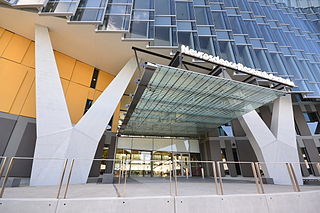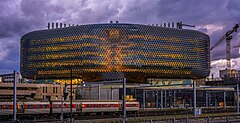
The University of Adelaide is a public research university located in Adelaide, South Australia. Established in 1874, it is the third-oldest university in Australia. The university's main campus is located on North Terrace in the Adelaide city centre, adjacent to the Art Gallery of South Australia, the South Australian Museum, and the State Library of South Australia.

Sir William Henry Bragg was an English physicist, chemist, mathematician, and active sportsman who uniquely shared a Nobel Prize with his son Lawrence Bragg – the 1915 Nobel Prize in Physics: "for their services in the analysis of crystal structure by means of X-rays". The mineral Braggite is named after him and his son. He was knighted in 1920.

In medicine, proton therapy, or proton radiotherapy, is a type of particle therapy that uses a beam of protons to irradiate diseased tissue, most often to treat cancer. The chief advantage of proton therapy over other types of external beam radiotherapy is that the dose of protons is deposited over a narrow range of depth; hence in minimal entry, exit, or scattered radiation dose to healthy nearby tissues.

The Royal Adelaide Hospital (RAH), colloquially known by its initials or pronounced as "the Rah", is South Australia's largest hospital, owned by the state government as part of Australia's public health care system. The RAH provides tertiary health care services for South Australia and provides secondary care clinical services to residents of Adelaide's central metropolitan area, which includes the inner suburbs.

North Terrace is one of the four terraces that bound the central business and residential district of Adelaide, the capital city of South Australia. It runs east–west, along the northern edge of "the square mile". The western end continues on to Port Road, and the eastern end continues across the Adelaide Parklands as Botanic Road.
The Australian Research Council (ARC) is the primary non-medical research funding agency of the Australian Government, distributing more than A$800 million in grants each year. The Council was established by the Australian Research Council Act 2001, and provides competitive research funding to academics and researchers at Australian universities. Most health and medical research in Australia is funded by the more specialised National Health and Medical Research Council (NHMRC), which operates under a separate budget.

Jay Wilson Weatherill is an Australian politician who was the 45th Premier of South Australia, serving from 21 October 2011 until 19 March 2018. Weatherill represented the House of Assembly seat of Cheltenham as a member of the South Australian Labor Party from the 2002 election to 17 December 2018, when he retired.
The National Health and Medical Research Council (NHMRC) is the main statutory authority of the Australian Government responsible for medical research. It was the eighth largest research funding body in the world in 2016, and NHMRC-funded research is globally recognised for its high quality. Around 45% of all Australian medical research from 2008–12 was funded by the federal government, through the NHMRC.

The Victor Chang Cardiac Research Institute (VCCRI) is an Australian non-profit medical research facility that is dedicated to finding cures for cardiovascular disease. With headquarters located in Darlinghurst, New South Wales, the research hub is home to more than 20 research laboratories and the Victor Chang Cardiac Research Institute Innovation Centre. The institute's mission is "the relief of pain and suffering, and the promotion of well-being, through an understanding of the fundamental mechanisms of cardiovascular disease". Its key research is focused on the prevention and treatment of various heart diseases, including arrhythmia, cardiac arrest, cardiomyopathy, congenital heart disease, heart attack, heart failure, high cholesterol, obesity, spontaneous coronary artery dissection (SCAD) and stroke.

Woods Bagot is a global architectural and consulting practice founded in Adelaide, South Australia. It specialises in the design and planning of buildings across a wide variety of sectors and disciplines. Former names of the practice include Woods & Bagot, Woods, Bagot & Jory; Woods, Bagot, Jory & Laybourne Smith; Woods, Bagot, Laybourne-Smith & Irwin; and Woods Bagot Architects Pty Ltd.

Louis Edouard Laybourne Smith CMG was an architect and educator in South Australia. Born in the Adelaide inner-southern suburb of Unley, he became interested in engineering and architecture while in the goldfields of Western Australia and later studied mechanical engineering at the School of Mines, serving an apprenticeship under architect Edward Davies. After graduating he accepted a position as a lecturer at the school, and was responsible for developing the first formal architecture course in the State in 1904. Between 1905 and 1914, he served as registrar at the school before leaving to join his long-time friend, Walter Bagot, at the architectural firm of Woods, Bagot and Jory. He remained with the firm until his death in 1965, and over the years was involved in a number of significant projects, including the South Australian National War Memorial and the original Australian Mutual Provident building on King William Street.

Walter Hervey Bagot was a South Australian architect. He was one of the last great proponents of the traditional school of South Australian architecture. He founded Woods & Bagot in 1905.

Neuroscience Research Australia is an independent medical research institute based in Sydney, Australia. Previously called the Prince of Wales Medical Research Institute, the institute relaunched as Neuroscience Research Australia on 1 June 2010. NeuRA is accredited by the National Health and Medical Research Council.

The Royal Institution of Australia (RiAus) is a national scientific not-for-profit organisation with a mission to "bring science to people and people to science". It opened in October 2009.

Konrad Pesudovs is an Australian optometrist and outcomes researcher in ophthalmology; recognised as the leading optometrist researcher worldwide in terms of H-Index and total citations. He is SHARP Professor of Optometry and Vision Science at the University of New South Wales (2020-). He was the Foundation Chair of Optometry and Vision Science at Flinders University from 2009 to 2017.

Stirling Griff is an Australian former politician who was a Senator for South Australia from 2016-2022, representing the Nick Xenophon Team and Centre Alliance. His party changed its name from Nick Xenophon Team (NXT) led by Senator Nick Xenophon to Centre Alliance in April 2018 after Xenophon ceased to be connected with the party. He served as deputy leader of the party in the Senate until April 2018, when it adopted its current name. He was also the NXT spokesperson for health, immigration and communications. He was defeated at the 2022 federal election, having only secured 3% of the vote. His term expired on the 30th June, 2022.
Lot Fourteen is a business and technology precinct at the eastern end of North Terace in Adelaide city centre, South Australia. The 7 ha (17-acre) site formerly accommodated the old Royal Adelaide Hospital, which was moved to a new building at the western end of North Terrace in 2017. Its name was derived from the original 1837 plan for Adelaide by surveyor-general Colonel William Light. By 2020, refurbished hospital buildings were home to a large number of tenants, and further new buildings and public spaces are planned, scheduled for completion around 2025. The redevelopment of the site has been led by the Department of the Premier and Cabinet.

Stephen J. Nicholls FRACP, FACC, FESC, FAHA, FAHMS, is an Australian cardiologist. He was appointed to the position of director of MonashHeart, Monash Health and professor of cardiology, Monash University in October 2018. He will be the inaugural clinical director of the Victorian Heart Hospital, due to open in late 2022. He is also the inaugural director of Monash University’s Victorian Heart Institute, an organisation dedicated to creating the cardiovascular health solutions of the future.

Harrold Herbert Jory, known as Herbert Jory, was a South Australian architect. He was a partner in the leading firm of Woods, Bagot & Jory from 1913, which became Woods, Bagot, Jory & Laybourne Smith from 1915 to 1930, before establishing his own practice, H. H. Jory. Between 1930 and 1940 he partnered with T.A. McAdam, in Jory and McAdam.

Emily Banks is an epidemiologist and public health physician, working mainly on chronic disease. She is a Professor of Epidemiology and Public Health and Head of the Centre for Public Health Data and Policy at the Australian National University, and a visiting Professor at the University of Oxford.


















